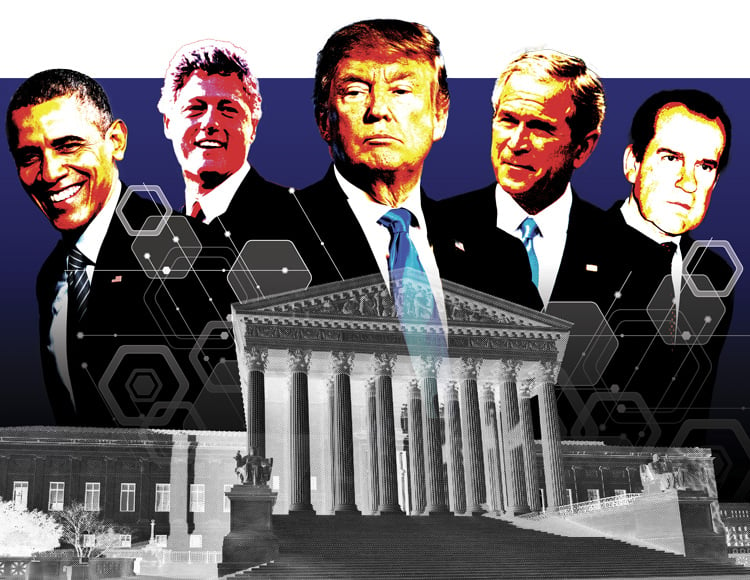The President's Court

Most recent presidents have had notable encounters with the Supreme Court. Photo illustration by Brenan Sharp.
‘Passionate Political Debate’
As for the specifics of the travel ban case, the high court’s June 26 per curiam opinion ordered, among other things, that the merits be argued during the court’s October sitting. Those arguments are set for Oct. 10.
At issue is Trump’s March 6 executive order that U.S. entry be denied to nationals of six predominantly Muslim countries—Iran, Libya, Somalia, Sudan, Syria and Yemen. The order states that conditions in those countries “demonstrate why their nationals continue to present heightened risks to the security of the United States,” and that “some of those who have entered the United States through our immigration system have proved to be threats to our national security.”
The president’s order explained that the pause was necessary while the administration is working to establish “adequate standards … to prevent infil0tration by foreign terrorists.” (The order differed in some respects from its original Jan. 27 iteration.)
The order was challenged in one of the cases before the high court by U.S. citizens and lawful permanent residents who want to welcome spouses or other relatives from the six countries. The suit, by groups such as the International Refugee Assistance Project and the Middle East Studies Association of North America, claims that the travel ban violates the First Amendment’s prohibition on government establishment of religion because it was motivated not by national security concerns but by animus toward Islam. A federal district court entered a nationwide injunction against the ban, and the full 4th U.S. Circuit Court of Appeals at Richmond, Virginia, affirmed, concluding there was a direct link between Trump’s numerous campaign statements that promised a Muslim ban related to certain territories and the executive order.
The other challenge before the court comes from the state of Hawaii and a U.S. citizen whose Syrian mother-in-law is seeking admittance to the United States. That suit led to a ruling by the 9th Circuit at San Francisco, not on constitutional grounds but that portions of the executive order likely exceeded the president’s authority under the Immigration and Nationality Act.
The Trump administration brought both cases to the high court.
“This order has been the subject of passionate political debate,” the acting U.S. solicitor general, Jeffrey B. Wall, told the justices in one brief. “But whatever one’s views, the precedent set by this case for the judiciary’s proper role in reviewing the president’s national security and immigration authority will transcend this debate, this order and this constitutional moment.”
After the parties skirmished over briefs, potential mootness and other issues late in the Supreme Court’s term, anticipation built for how the justices would handle the case.
Chief Justice John G. Roberts Jr. announced the per curiam opinion as his last order of business from the bench on the term’s final day. The unsigned—though not unanimous—opinion tinkered with the nationwide injunction by narrowing it significantly.
In practical terms, the opinion said, the ban “may not be enforced against foreign nationals who have a credible claim of a bona fide relationship with a person or entity in the United States.”
For individuals, this would mean “a close familial relationship,” the court said. (The Trump administration soon caused fresh controversy by issuing regulations that counted, for example, a mother-in-law as a close relationship but excluded grandparents from the definition. Amid legal skirmishing over those rules, the Supreme Court in July upheld a lower court’s order that expanded the definition to include grandparents, aunts, uncles and some other relatives as close family ties. But the justices allowed the regulation’s tight definition of refugees to take effect.)
In the June per curiam, three justices—Clarence Thomas, Samuel A. Alito Jr. and Gorsuch—dissented in part, saying they would stay the injunctions in full and allow that travel ban to go into effect.

Josh Blackman
Thomas, writing for those three, said, “Weighing the government’s interest in preserving national security against the hardships caused to respondents by temporary denials of entry into the country, the balance of the equities favors the government.”
The per curiam decision “is very muscular,” Clement says. “It’s setting the stage for a case that is going to be very closely watched.”
Blackman notes language by Thomas referring to “the court’s implicit conclusion that the government has made a strong showing that it is likely to succeed on the merits—that is, that the judgments below will be reversed.”
“I think that the court has, by the brief per curiam opinion, signaled that the lower courts got it wrong,” he says. “There has been an urgency [on the left] to stop Trump in the courts, and I think the Supreme Court put that on ice for now.”
Those views presuppose that the court is inclined to rule on the merits of the travel ban, though the justices seem to have given themselves some off ramps. The per curiam asks the parties to address whether the challenges to the key provisions of the March executive order became moot on June 14, which was 90 days after its effective date.

Leah Litman, photo courtesy of University of California, Irvine.
Some legal observers have suggested that even under a more generous reading of when the order became effective, its 90 days would still expire before the Supreme Court takes up the case during the new term.
“Absent some significant change before the court hears the case in October, I think it’s likely we won’t get a ruling on the merits,” says Leah Litman, an assistant law professor at the University of California at Irvine.
That may be so in the end, but the justices have shown they are willing to put the high-profile dispute front and center as their marquee case as the new term opens.
Besides the travel ban case, there are other potential blockbusters in the wings.
Mark Walsh is a freelance writer based in Washington, D.C. This article appeared in the October 2017 issue of the
Write a letter to the editor, share a story tip or update, or report an error.



